I am a bit late to answer this, but for anyone who is still facing this Problem, Please take a look at this Library:
Quick Setup
Adding the view to a layout
<com.sababado.circularview.CircularView
android:id="@+id/circular_view"
android:layout_width="match_parent"
android:layout_height="match_parent"
app:centerBackgroundColor="#33b5e5"
app:centerDrawable="@drawable/center_bg"/> Using the custom attributes requires the following in the layout file. Example
xmlns:app="http://schemas.android.com/apk/res-auto" Adding Markers
A Marker is an object that visual "floats" around the view. Each
marker is can represent data or it can simply be for visual effect.
Markers must be customized through a CircularViewAdapter.
public class MySimpleCircularViewAdapter extends
SimpleCircularViewAdapter {
@Override
public int getCount() {
// This count will tell the circular view how many markers to use.
return 20;
}
@Override
public void setupMarker(final int position, final Marker marker) {
// Setup and customize markers here. This is called every time a marker is to be displayed.
// 0 >= position > getCount()
// The marker is intended to be reused. It will never be null.
marker.setSrc(R.drawable.ic_launcher);
marker.setFitToCircle(true);
marker.setRadius(10 + 2 * position);
} }
Once the CircularViewAdapter implementation is ready it can be set on a CircularView object.
mAdapter = new MySimpleCircularViewAdapter(); circularView =
(CircularView) findViewById(R.id.circular_view);
circularView.setAdapter(mAdapter); Receiving click listeners
Click events can be received from the CircularView.
To receive click events set a CircularView.OnClickListener into
circularView.setOnCircularViewObjectClickListener(l).
For example:
circularView.setOnCircularViewObjectClickListener(new
CircularView.OnClickListener() {
public void onClick(final CircularView view) {
Toast.makeText(MainActivity.this, "Clicked center", Toast.LENGTH_SHORT).show();
}
public void onMarkerClick(CircularView view, Marker marker, int position) {
Toast.makeText(MainActivity.this, "Clicked " + marker.getId(), Toast.LENGTH_SHORT).show();
} }); Animation
There are a few simple animations built into the library at the
moment.
Animate Highlighted Degree
The CircularView has animateHighlightedDegree(start, end, duration).
The method takes a start and end position in degrees, and a long value
for the duration of the animation. The highlighted degree refers to
which degree is "highlighted" or "focused". When a degree is focused
it can trigger a secondary animation automatically for a Marker.
A listener can be set to receive a callback when this animation ends,
and on what object it stopped on.
circularView.setOnHighlightAnimationEndListener(new
CircularView.OnHighlightAnimationEndListener() {
@Override
public void onHighlightAnimationEnd(CircularView view, Marker marker, int position) {
Toast.makeText(MainActivity.this, "Spin ends on " + marker.getId(), Toast.LENGTH_SHORT).show();
} }); Marker Animation Options
Markers have a simple animation associated with them; up and down. It
can repeat or it can happen once. The CircularView can trigger the
bounce animation when animateHighlightedDegree(start, end, duration)
is called. The bounce animation can be turned off by calling the same
method with an additional flag. For example:
animateHighlightedDegree(start, end, duration, shouldAnimateMarkers)
In addition there is control over if a marker should bounce while it
is highlighted and while the highlighted degree value is constant (aka
not animating).
// Allow markers to continuously animate on their own when the
highlight animation isn't running.
circularView.setAnimateMarkerOnStillHighlight(true); // Combine the
above line with the following so that the marker at it's position will
animate at the start.
circularView.setHighlightedDegree(circularView.BOTTOM); The latter
line is necessary in case the bounce animation should also run
initially. The highlighted degree is set to
CircularView.HIGHLIGHT_NONE by default.
Proguard
If using proguard add the following to your proguard script to make
sure animations run
# keep setters in Views so that animations can still work.
# see http://proguard.sourceforge.net/manual/examples.html#beans
-keepclassmembers public class * extends android.view.View { void set*(***); *** get*(); }
# keep setters in CircularViewObjects so that animations can still work.
-keepclassmembers public class * extends com.sababado.circularview.CircularViewObject { void set*(***);
*** get*(); } Developer Hints
Every property that can be customized on a CircularViewObject can also
be customized on a Marker object. A Marker object extends from a
CircularViewObject. The former is used as a smaller object that floats
around the center object. The center object is a CircularViewObject.
By default, markers are drawn in the order that they're created;
meaning if markers overlap then the first marker will be partially
covered by the next marker. An option can be set to draw the
highlighted marker on top of the markers next to it with
circularView.setDrawHighlightedMarkerOnTop(true);. The flag is false
by default. Any CircularViewObject can be hidden and shown
independently of other objects using setVisibility(int) In a layout
editor use the attribute editMode_markerCount and
editMode_markerRadius to see the size and layout of markers. Not
supplying a radius will show the default radius. It does exactly what
is asked in Question.
I hope this helps.



